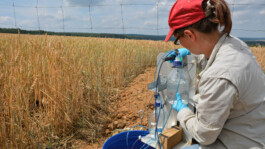



Climate change underground
Collaborative Research Center ”AquaDiva”; Hydrogeology Group, Institute for Geosciences, University of Jena
Geologist Dr. Katharina Lehmann takes seepage samples from a cropland soil in the Hainich. In the laboratories in Jena, nutrients, microorganisms, and mobile solids contained therein are examined. In the Collaborative Research Centre "AquaDiva," such results from long-term monitoring in the soil help to understand the links between above- and belowground habitats and inhabiting organisms (ecosystems). How constituents fluctuate within days or years and provide replenishment to deeper groundwater habitats ultimately impacts our drinking water. Researchers at the Chair of Hydrogeology investigate the subsurface effects of climate change, which can be seen, for example, in dried-out soils and less frequent snowmelts.
© Robert Lehmann

Climate change underground
Collaborative Research Center ”AquaDiva”; Hydrogeology Group, Institute for Geosciences, University of Jena
Geologist Dr. Katharina Lehmann takes seepage samples from a cropland soil in the Hainich. In the laboratories in Jena, nutrients, microorganisms, and mobile solids contained therein are examined. In the Collaborative Research Centre "AquaDiva," such results from long-term monitoring in the soil help to understand the links between above- and belowground habitats and inhabiting organisms (ecosystems). How constituents fluctuate within days or years and provide replenishment to deeper groundwater habitats ultimately impacts our drinking water. Researchers at the Chair of Hydrogeology investigate the subsurface effects of climate change, which can be seen, for example, in dried-out soils and less frequent snowmelts.
© Robert Lehmann